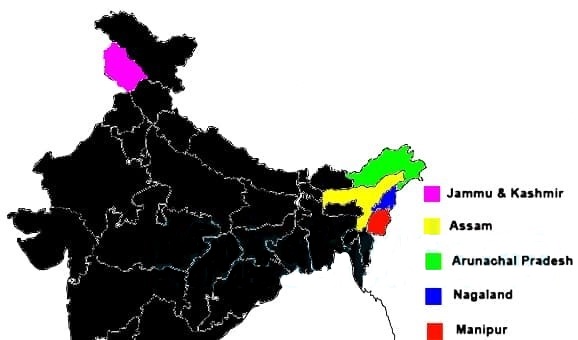Delimitation Commission for North Eastern States
2020 MAR 7
Mains >
Polity > Institutions/Bodies > Election Commission

IN NEWS:
The Central government has constituted a delimitation commission for four north eastern states and the Union Territory of J&K.
WHAT IS DELIMITATION?
- A basic principle in democracy is ‘One person, one vote, one value’, which implies that every voter shares same value for the vote he/she casts. For that every constituency must have more or less equal amount of population. But the population of a constituency can change over a period of time which makes rearrangement of electoral constituencies a necessity. It may involve redrawing of boundaries or creating new constituencies. This process is known as delimitation.
- In India, articles 82 and 170 of the constitution lays down the provisions of delimitation of Lok Sabha and assembly constituencies respectively. Parliament may create an authority by law to carry out delimitation after each census and the authority so created is known as Delimitation commission.
STRUCTURE AND FUNCTIONS:
- It is a high-power body whose orders have the force of law and cannot be called in question before any court. But the commission is not a permanent body. It is a statutory body created every time by the parliament when delimitation is required.
- It shall consist of three members as follows:
- A former or existing Judge of the Supreme court as its chairperson
- Chief Election Commissioner or an Election Commissioner nominated by the Chief Election Commissioner
- State Election Commissioner of concerned State
- The Commission shall associate with ten persons, five of whom shall be members of the House of the People representing that State and five shall be members of the Legislative Assembly of that State.
DELIMITATION AND AMENDMENT ACTS:
- Delimitation exercises were carried out in 1952, 1963 and 1973 by Delimitation commissions created under their respective acts.
- But in 1976, the 42nd Amendment Act of 1976 froze the allocation of seats in the Lok Sabha to the states and the division of each state into territorial constituencies till the year 2000 at the 1971 level. This was done so that the states who took population control measures are not discouraged as they might lose few seats when the population growth comes down. Hence, the fourth delimitation due in 1981-82 could not take place.
- In 2002, the fourth Delimitation commission was constituted to redraw constituencies based on 2001 census.
- Through the 84th Amendment Act of 2001, the ban on readjustment was extended for another 25 years (ie, upto year 2026), with the same objective of encouraging population limiting measures.
- Later, the 87th Amendment Act of 2003 provided for the delimitation of constituencies on the basis of 2001 census and not 1991 census.
WHY THE COMMISSION HAS NOW BEEN CREATED ONLY FOR FEW STATES IN INDIA?
- The fourth Commission completed the delimitation exercise and the Delimitation Order, 2008 in respect of all the states, except in these four north eastern states because of the unfavourable security situation and rising insurgency. Now the circumstances that led to the deferring of the delimitation exercise in these states have ceased to exist and delimitation of the constituencies as envisaged under the Delimitation Act, 2002 could be carried out.
- Also the number of seats in the Legislative Assembly of Union territory of Jammu and Kashmir shall be increased from 107 to 114 according to the Jammu and Kashmir Reorganisation Act 2019.The new commission will carry out these functions.
ISSUES WITH DELIMITATION IN INDIA:
- Crisis of representation: Freezing Lok Sabha seats violates the basic constitutional and democratic principle of one person, one vote, one value as there is interstate disparity of population-constituency ratio . Some constituencies will have larger population when compared to others.
- Accountability: The freezing of the number of seats has also led to large sized constituencies which is beyond the capacity of a representative to manage. This in turn compromised the political accountability of the elected. This has resulted in a gap between the electors and the elected.
- Irregularity: The constitutional makers wanted delimitation after every census. This has not been followed.
- Urbanization: The commission failed to plan delimitation by keeping in mind the population changes in cities due to rapid urbanisation and migration.
- Associate members: The presence of politicians as associate members is often criticised for alleged political influence in the process.
WAY FORWARD:
- There is a need for carrying out delimitation at regular intervals. There is no credible evidence to suggest any relationship between freezing seats and population growth.
- Number of seats to Lok sabha can be increased so that states who successfully performed population control measures do not lose political space. Also Rajya sabha is the platform to raise the concern of states. Measures can be taken to address issues of representation there rather than Lok sabha.
- Election commission must be given greater role in the delimitation process.
- The issue with associate members can be addressed with necessary amendments to the governing act.
PRACTICE QUESTION:
Q. What do you mean by delimitation of constituencies? Do you think fresh delimitation should be carried out all over the country?
